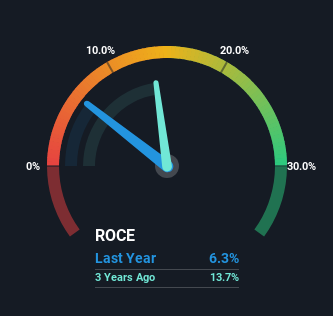- China
- /
- Metals and Mining
- /
- SZSE:002237
Investors Could Be Concerned With Shandong Humon Smelting's (SZSE:002237) Returns On Capital

What are the early trends we should look for to identify a stock that could multiply in value over the long term? Amongst other things, we'll want to see two things; firstly, a growing return on capital employed (ROCE) and secondly, an expansion in the company's amount of capital employed. Ultimately, this demonstrates that it's a business that is reinvesting profits at increasing rates of return. Although, when we looked at Shandong Humon Smelting (SZSE:002237), it didn't seem to tick all of these boxes.
Understanding Return On Capital Employed (ROCE)
Just to clarify if you're unsure, ROCE is a metric for evaluating how much pre-tax income (in percentage terms) a company earns on the capital invested in its business. The formula for this calculation on Shandong Humon Smelting is:
Return on Capital Employed = Earnings Before Interest and Tax (EBIT) ÷ (Total Assets - Current Liabilities)
0.063 = CN¥1.0b ÷ (CN¥24b - CN¥8.2b) (Based on the trailing twelve months to March 2024).
Thus, Shandong Humon Smelting has an ROCE of 6.3%. In absolute terms, that's a low return but it's around the Metals and Mining industry average of 6.7%.
View our latest analysis for Shandong Humon Smelting

In the above chart we have measured Shandong Humon Smelting's prior ROCE against its prior performance, but the future is arguably more important. If you'd like, you can check out the forecasts from the analysts covering Shandong Humon Smelting for free.
How Are Returns Trending?
When we looked at the ROCE trend at Shandong Humon Smelting, we didn't gain much confidence. Around five years ago the returns on capital were 14%, but since then they've fallen to 6.3%. Although, given both revenue and the amount of assets employed in the business have increased, it could suggest the company is investing in growth, and the extra capital has led to a short-term reduction in ROCE. If these investments prove successful, this can bode very well for long term stock performance.
On a related note, Shandong Humon Smelting has decreased its current liabilities to 34% of total assets. That could partly explain why the ROCE has dropped. What's more, this can reduce some aspects of risk to the business because now the company's suppliers or short-term creditors are funding less of its operations. Since the business is basically funding more of its operations with it's own money, you could argue this has made the business less efficient at generating ROCE.
Our Take On Shandong Humon Smelting's ROCE
In summary, despite lower returns in the short term, we're encouraged to see that Shandong Humon Smelting is reinvesting for growth and has higher sales as a result. However, despite the promising trends, the stock has fallen 36% over the last five years, so there might be an opportunity here for astute investors. So we think it'd be worthwhile to look further into this stock given the trends look encouraging.
Shandong Humon Smelting does have some risks though, and we've spotted 3 warning signs for Shandong Humon Smelting that you might be interested in.
While Shandong Humon Smelting may not currently earn the highest returns, we've compiled a list of companies that currently earn more than 25% return on equity. Check out this free list here.
New: Manage All Your Stock Portfolios in One Place
We've created the ultimate portfolio companion for stock investors, and it's free.
• Connect an unlimited number of Portfolios and see your total in one currency
• Be alerted to new Warning Signs or Risks via email or mobile
• Track the Fair Value of your stocks
Have feedback on this article? Concerned about the content? Get in touch with us directly. Alternatively, email editorial-team (at) simplywallst.com.
This article by Simply Wall St is general in nature. We provide commentary based on historical data and analyst forecasts only using an unbiased methodology and our articles are not intended to be financial advice. It does not constitute a recommendation to buy or sell any stock, and does not take account of your objectives, or your financial situation. We aim to bring you long-term focused analysis driven by fundamental data. Note that our analysis may not factor in the latest price-sensitive company announcements or qualitative material. Simply Wall St has no position in any stocks mentioned.
About SZSE:002237
Shandong Humon Smelting
Engages in the development of gold mineral resources; precious metal smelting; research and development, and production of high-tech materials; and international trade business in China and internationally.
Reasonable growth potential and fair value.
Market Insights
Community Narratives



